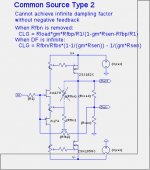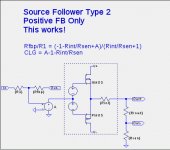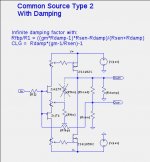I assume that your are using the term "positive current feedback" to mean "positive feedback" of the sensed "output current". [Yes]
The circuit topologies I presented earlier in this thread provide equations for the feedback resistors which create (theoretically) zero output impedance. If the negative feedback resistance is forced to infinite (i.e. is removed), the equations cannot be satisfied and the circuit WILL not performs as desired.
You question is whether one could create a useful amplifier with only positive feedback. The following is the Type-2 configuration without the negative feedback resistor. With suitable choice of the positive feedback resistor with will work and not oscillate. But the without negative feedback the output voltage is linearly dependent on the impedance of the (speaker) load [or a current source amp]. The only reason I can see for using positive feedback in this manner is to increase to Gm of the circuit.
Thanks lhquam for your analysis. I understand that the modified Type 2 becomes a current source power amp. Its output DC offset may wander; because its absent ONF would otherwise stabilize it.
Positive current feedback will increase the gain very dramatically if there is no negative feedback at all. I have been simulating my PCF-Zen without any global negative feedback but with some local source-degeneration. I can get pretty decent distortion levels from a simple one stage amp with PCF.
My simple autotransformer-coupled source-follower amp sounded real nice with some PCF.
It is a very interesting concept.
Cheers,
Johannes
My simple autotransformer-coupled source-follower amp sounded real nice with some PCF.
It is a very interesting concept.
Cheers,
Johannes
Thank you Mr. Pass. Fortunately, diyF5 [and diyF6] are decent power amplifiers without negative feedback.There is no requirement that the amplifier has to have a negative feedback
loop. If you can make a decent amplifier without it, then you can apply
positive current feedback.

There is no requirement that the amplifier has to have a negative feedback
loop. If you can make a decent amplifier without it, then you can apply
positive current feedback.

I finally decided to perform some mathematical analysis of amplifier typologies having positive feedback but no negative feedback.
The first example was the F7 topology candidate that I designated as "Type-2" in earlier posts. When I attempt to remove all (global) negative feedback, the resulting amplifier has an zero damping factor. This is because the F7 has a (push-pull) Common-Source output stage and is essentially a transconductance amplifier requiring negative feedback to achieve any significant damping factor.
The image below shows the circuit and some related equations.
In order to control the da
Attachments
Having determined that (pure) Common-Source output stages require negative feedback to achieve a damping factor I decided to try a Source-Follower output stage, preceded by a differential gain stage with a voltage gain of A. The resistor Rint characterizes the internal resistance of the output stage.
The image below shows the circuit which has only positive global feedback, and the parameters for achieving an infinite damping factor of the resulting amplifier.
The image below shows the circuit which has only positive global feedback, and the parameters for achieving an infinite damping factor of the resulting amplifier.
Attachments
Having determined that (pure) Common-Source output stages require negative feedback to achieve a damping factor I decided to try a Source-Follower output stage, preceded by a differential gain stage with a voltage gain of A. The resistor Rint characterizes the internal resistance of the output stage.
The image below shows the circuit which has only positive global feedback, and the parameters for achieving an infinite damping factor of the resulting amplifier.
Hello lhquam. Maybe diyF4, and those with the asymmetric output stage? diyF5, and diyF6 are out of contention. Thanks lhquam.
Yes, the F4 and other source-follower amps preceded with suitable gain stages are candidates for damping factor control using positive feedback without global negative feedback.Hello lhquam. Maybe diyF4, and those with the asymmetric output stage? diyF5, and diyF6 are out of contention. Thanks lhquam.
The F5, F6, and F7 are not candidates, since they have common-source output stages.
Here is an example for a source-follower output stage: The FirstWatt F4 specifications show Rint=0.2 Ohms. If we choose Rsen=Rint, and CLG=5 (closed-loop gain of the combined front-end gain stage and the F4 with positive feedback), we get the required gain of the front-end gain-stage to be A=7, and Rfpb = 2.5*R1.
Having determined that (pure) Common-Source output stages require negative feedback to achieve a damping factor...
I guess it would depend on what you mean by pure. If the amp has a
non-zero damping factor, then it is conceptually, if not practically, possible.
For example, imagine a Common Source output stage loaded to ground by
some resistance, that resistance providing the damping factor.
Practically speaking though, we would use a Common Drain output stage for
a no-negative-feedback version.
Yes, with some (resistive) damping, a common-source amplifier can exploit positive feedback without needing negative feedback. Below is a the circuit of post #645 http://www.diyaudio.com/forums/pass-labs/275921-first-watt-f7-review-65.html#post4732415 with a damping resistor added. Shown are the equations for positive feedback resistor that achieves an infinite damping factor, and the resulting closed-loop gain (CLG).
Here are a couple of example sets of values:
gm=4, Rdamp=10, Rsen=.5 => CLG=19, Rfbp/R1=.905
gm=4, Rdamp=80, Rsen=.5 => CLG=159, Rfbp/R1=.988
Here are a couple of example sets of values:
gm=4, Rdamp=10, Rsen=.5 => CLG=19, Rfbp/R1=.905
gm=4, Rdamp=80, Rsen=.5 => CLG=159, Rfbp/R1=.988
Attachments
F7’s performance as nothing less than a “full-nelson.”
Dick Olsher, Absolute Sound
7x
than just imagine how good amp is my Papa able to make ....... being at least trice smarter than his (even full ) Nelson

You need to purchase the magazine online if you want to read it right now.
http://www.theabsolutesound.com/publications/the-absolute-sound/issues/263/
http://www.theabsolutesound.com/publications/the-absolute-sound/issues/263/
No brother, it is mine!

Since we are brothers, it's safe to say that he is both our Papa.
But he loves me more.

Last edited:
- Home
- Amplifiers
- Pass Labs
- First Watt F7 review


